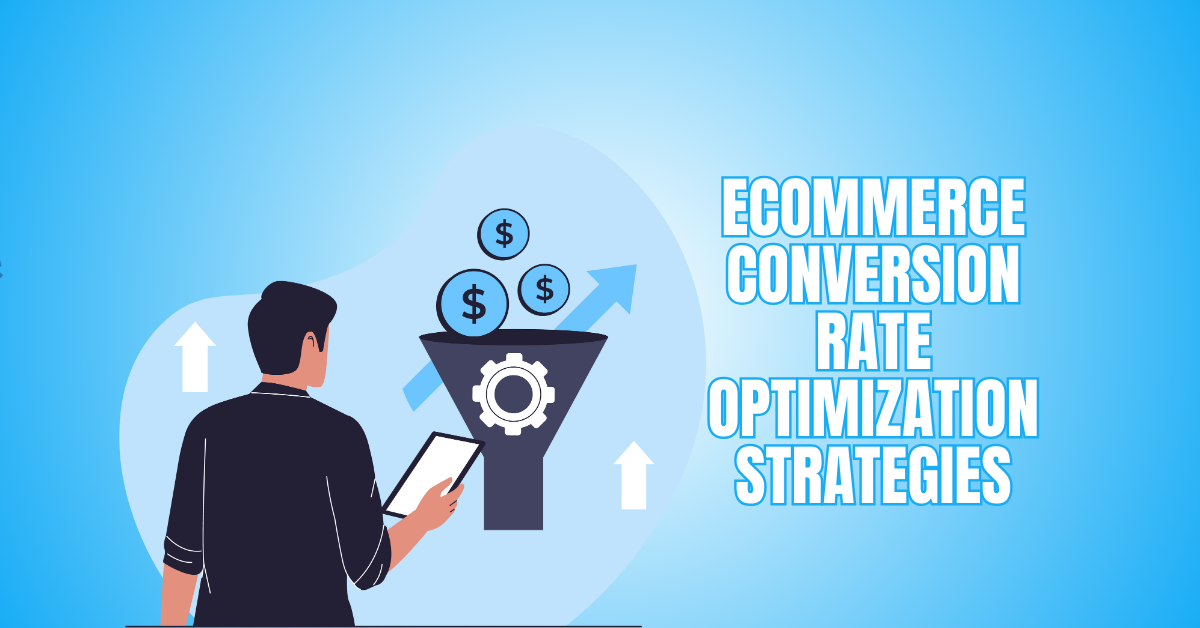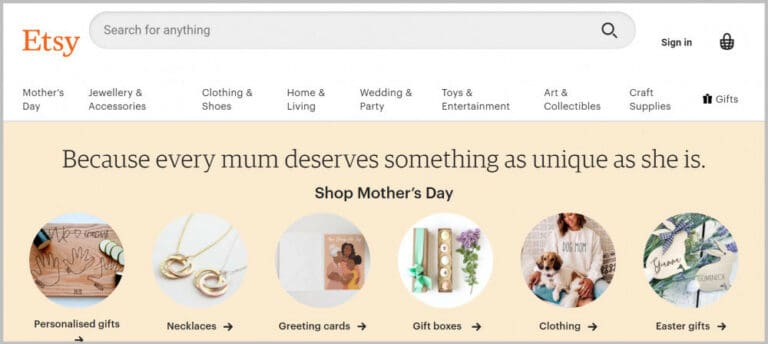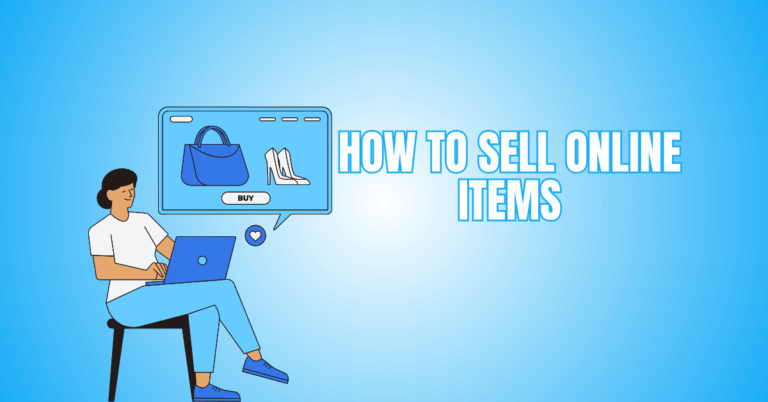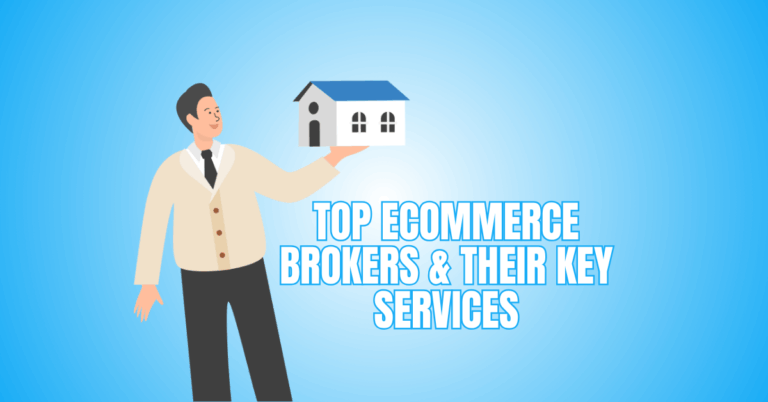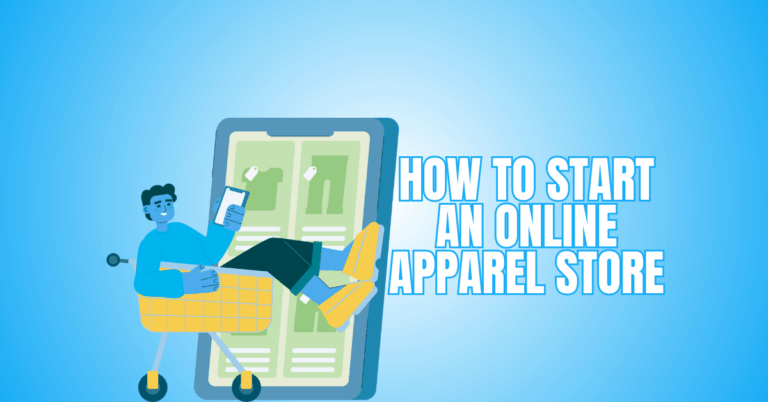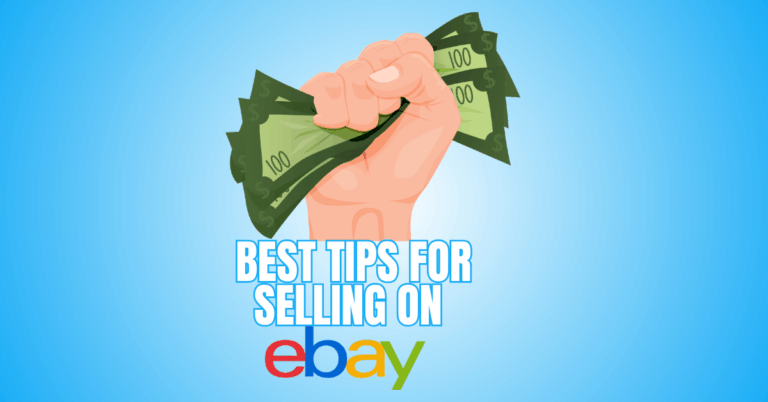Proven eCommerce Conversion Rate Optimization Strategies
eCommerce conversion rate optimization is the key to turning visitors into loyal customers. In today’s competitive online market, even minor improvements can dramatically boost your sales and revenue.
This blog explores proven strategies, practical tips, and actionable techniques that help you enhance user experience, increase trust, and drive conversions.
Whether you’re a beginner or a seasoned seller, mastering eCommerce conversion rate optimization can transform your online store’s performance.
What is eCommerce Conversion Rate Optimization?
The process of making your online business better so that more customers take significant actions, such as buying something, subscribing to your email, or adding products to their basket, is known as eCommerce Conversion Rate Optimization, or CRO.
In simple terms, it’s about turning browsers into buyers. Instead of only focusing on getting more traffic, CRO helps you make better use of the traffic you already have.
For example, if 1,000 people visit your store and 20 buy something, your conversion rate is 2%. By optimizing product pages, checkout, and user experience, you can raise that number—and boost sales without extra ad spend.
How To Calculate The Conversion Rate
It’s simple math: Conversion Rate = (Number of Conversions ÷ Total Visitors) × 100
Example: 50 purchases ÷ 2,000 visitors = 0.025 → 2.5% conversion rate.
You can calculate this for different actions: purchases, email signups, cart additions, or even clicks on a button.
eCommerce CRO Strategies That Work
eCommerce Conversion Rate Optimization helps online stores turn visitors into buyers. You can increase sales, decrease cart abandonment, and make every click matter for your company by using the appropriate tactics.
1. Improve Website Speed
One of the most important elements influencing conversions is website speed. A 1-second load time delay has been shown to reduce conversions by 7%. If it takes more than 3 seconds for your website to load, you run the risk of losing over 40% of visitors.
Purchasing faster hosting, optimizing images, and utilizing a content delivery network (CDN) can all help. For example, Walmart improved conversions by 2% for every 1-second improvement in speed.
Faster sites not only boost sales but also improve SEO rankings. Speed optimization ensures shoppers stay engaged and reach checkout before losing patience.
Key Points
- Without sacrificing quality, lower file sizes can be achieved by compressing photographs.
- Use a Content Delivery Network (CDN) for faster global access.
- Invest in reliable, high-speed hosting solutions.
- Minimize plugins, scripts, and unnecessary code.
2. Optimize For Mobile
Over 70% of eCommerce traffic comes from mobile devices, yet many stores still provide clunky mobile experiences. If buttons are too small, checkout forms are complex to fill, or navigation is confusing, visitors won’t convert.
Mobile-first design ensures pages resize properly, load fast, and work smoothly on different devices. For example, fashion retailer ASOS improved sales significantly after revamping its mobile checkout flow.
Test your store on multiple smartphones to catch problems. A seamless mobile experience is essential because most buyers today shop while scrolling on their phones, not desktops.
Key Points
- Test buttons, menus, and forms for easy tapping.
- Prioritize fast-loading mobile pages.
- Simplify checkout for smaller screens.
- Use mobile-friendly images and fonts for better readability.
3. Write Clear And Persuasive Product Descriptions
Product descriptions are your chance to sell without being pushy. They should be clear, engaging, and persuasive. Instead of just listing features, highlight benefits—how the product makes life better.
For example, instead of “cotton T-shirt,” say “soft, breathable cotton T-shirt that keeps you cool all day.” According to Nielsen Norman Group, scannable, benefit-driven descriptions improve purchase decisions.
Use bullet points, short sentences, and natural language. Think like your customers: answer questions before they’re asked. When shoppers feel informed and connected, they’re more likely to click “Add to Cart.”
Key Points
- Highlight benefits (e.g., comfort, time-saving, durability).
- Use bullet points for scannable details.
- Write in a conversational, customer-focused tone.
- Add keywords naturally to support SEO.
4. Use High-Quality Product Images And Videos
Visuals play a massive role in online shopping. Research shows that 93% of consumers consider visuals a key factor in purchase decisions. High-quality photos from multiple angles help replace the in-store experience.
Lifestyle images, where products are shown in real use, build emotional connection. Adding product videos boosts trust even more—Zappos found videos increased conversions by 6–30%.
Include zoom-in features, 360-degree views, and short video demonstrations. The better shoppers can see your product, the easier it is for them to imagine owning it. Good visuals reduce hesitation and increase buying confidence.
Key Points
- Show products from multiple angles.
- Use lifestyle images to show products in real use.
- Add short demonstration videos.
- Include Zoom features for detailed views.
Wealthy Affiliate – Mini Review (2025)
If you’ve ever thought about turning your blog, passion, or niche into an online business,
Wealthy Affiliate (WA) is one of the most beginner-friendly platforms I’ve used.
It combines step-by-step training, website hosting, SEO research tools,
and an active community all in one place.
What I like most: you can start free (no credit card needed),
explore lessons, test the tools, and connect with other entrepreneurs
before upgrading. WA isn’t a “get rich quick” scheme —
It’s a platform where success comes from consistent effort and applying what you learn.
5. Add Customer Reviews And Testimonials
Social proof is powerful. Around 95% of shoppers read reviews before buying. Displaying reviews on product pages helps build trust, especially for new visitors.
For example, Amazon thrives because every product has reviews, ratings, and Q&A sections. Provide discounts or loyalty points to customers to entice them to submit reviews.
Even negative reviews can help, showing authenticity. In fact, research shows products with a mix of positive and moderate reviews sell better than those with only glowing praise.
Real testimonials on landing pages or checkout screens give hesitant shoppers the reassurance they need to buy.
Key Points
- Encourage buyers to leave reviews after purchase.
- Display reviews prominently on product pages.
- Use star ratings to summarize opinions quickly.
- Share testimonials across the homepage and checkout pages.

6. Simplify Your Checkout Process
70% is the average cart abandonment rate. A complicated checkout process is one of the leading causes of customer attrition.
Streamlining the process increases conversions. Add autofill functionality, minimize the number of form fields, and allow guest checkout.
For example, Baymard Institute research shows that lowering checkout fields from 15 to 7 can significantly increase completed purchases. Provide multiple payment methods and make “Buy Now” buttons visible.
Think of Apple’s one-click payment—frictionless and straightforward. Every unnecessary step you remove makes it easier for customers to finish their order without second thoughts.
Key Points
- Offer guest checkout for first-time buyers.
- Reduce the number of form fields required.
- Provide clear, step-by-step progress indicators.
- Accept multiple payment options for flexibility.
7. Display Trust Signals
Trust is the backbone of eCommerce. Shoppers want to know that their data and money are safe. Adding SSL certificates, trust badges, secure payment icons, and clear return policies reassures buyers.
According to Blue Fountain Media (now Pactera), adding trust symbols can increase conversions by 30%. For example, displaying “Money-Back Guarantee” or “Free Returns” badges can nudge hesitant buyers.
Transparency also matters—clearly show shipping costs, support contacts, and company details. When visitors feel your store is secure and trustworthy, they’ll be much more willing to complete their purchase without hesitation.
Key Points
- Add SSL certificates (TLS certificates) and secure payment icons.
- Show “Money-Back Guarantee” or return policy badges.
- Display clear contact information and support options.
- Highlight trusted brands or partnerships you work with.
8. Offer Free Shipping Or Transparent Costs
Hidden costs are the top reason for cart abandonment. A survey by Statista found 55% of shoppers abandon carts due to unexpected extra costs, mainly shipping.
Offering free shipping—even above a specific order value—can dramatically improve conversions. For example, Stitch Fix increased orders after introducing free returns and shipping.
If free shipping isn’t possible, be transparent about costs from the start. Display shipping details early on product pages or in the cart. Shoppers value honesty, and clarity helps them feel more comfortable proceeding to checkout.
Key Points
- Offer free shipping above a minimum order value.
- Display shipping costs upfront on product pages.
- Include clear estimated delivery times.
- Promote free returns to reduce purchase hesitation.
9. Use Scarcity And Urgency
Scarcity and urgency push shoppers to act faster. Limited-time offers, flash sales, or “only 3 left in stock” alerts can motivate purchases. Research from CXL Institute shows urgency messaging can lift conversions by up to 332%.
For example, Booking.com uses “X people are viewing this now” and “Only 2 rooms left” effectively. In eCommerce, countdown timers for deals or limited-edition product drops create FOMO (fear of missing out).
But don’t overuse fake scarcity—it can hurt trust. Authentic urgency taps into psychology and moves people from browsing to buying quickly.
Key Points
- Display “Only X left in stock” alerts.
- Use countdown timers for limited-time deals.
- Highlight flash sales or seasonal promotions.
- Show real-time notifications of other buyers.
10. Retarget Abandoned Carts
Most people won’t buy on their first visit. But abandoned cart retargeting helps bring them back. According to Barilliance, 45% of cart abandonment emails are opened, and 21% lead to purchases. You can set up email reminders offering discounts, free shipping, or simply showing the forgotten item.
For example, fashion brand Boohoo (now Debenhams Group) sends playful, image-rich cart recovery emails that successfully recover lost sales—retargeting ads on social media or Google also keep products in front of shoppers. A friendly nudge often turns a missed opportunity into a conversion.
Key Points
- Send cart recovery emails with reminders.
- Give customers incentives or discounts to finish the transaction.
- Use retargeting ads on social media.
- Personalize messages based on the abandoned items.
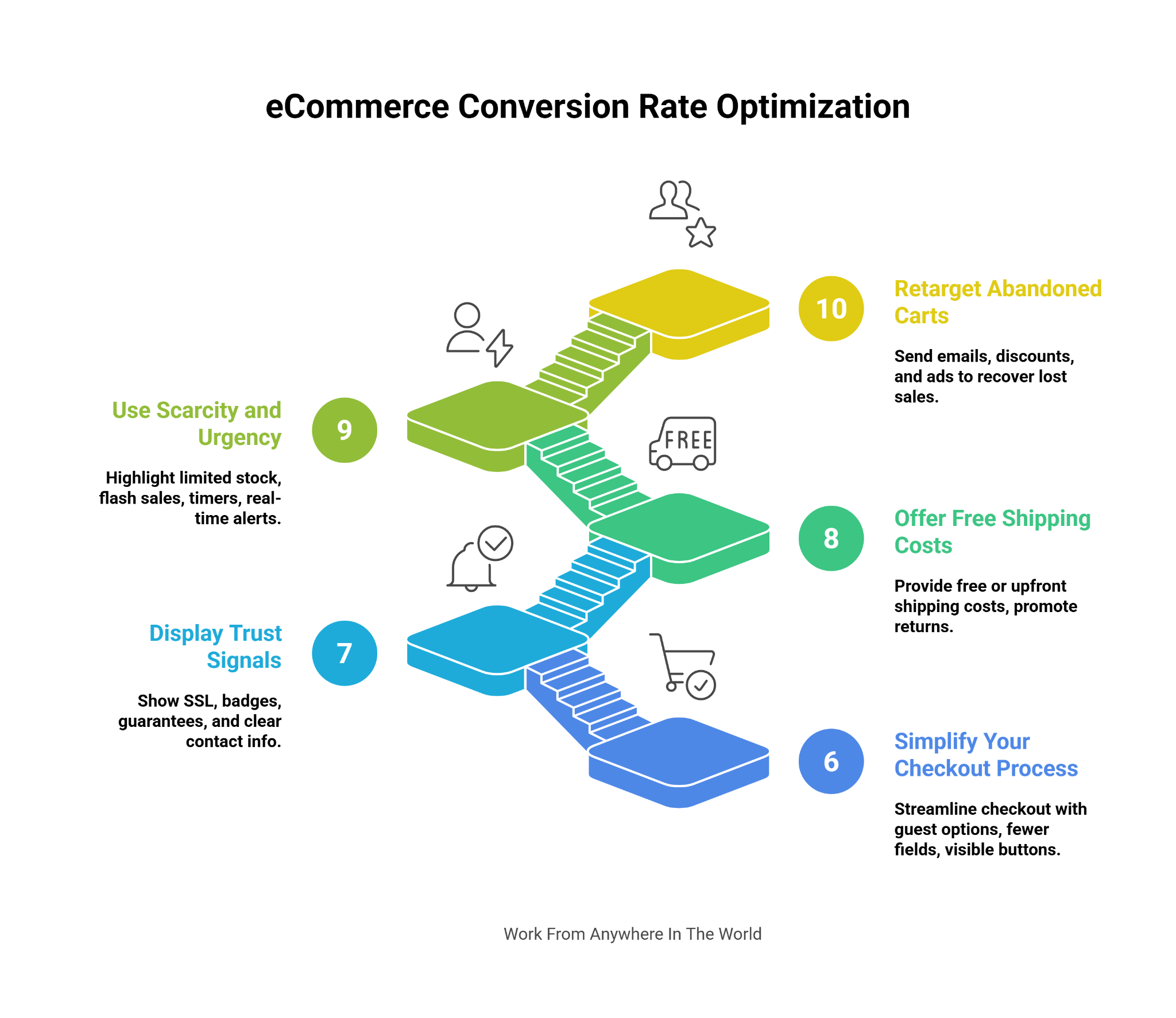
Why Conversion Rate Optimization Matters
Conversion Rate Optimization (CRO) helps eCommerce businesses turn more visitors into buyers. By improving user experience, checkout processes, and marketing strategies, CRO boosts sales, revenue, and long-term customer loyalty efficiently.
1. Boosts Revenue Without Extra Traffic
Conversion Rate Optimization allows businesses to increase sales from existing visitors rather than relying solely on attracting more traffic.
By improving website design, product pages, and checkout flows, stores can encourage more users to complete purchases.
Even minor adjustments, like optimizing call-to-action buttons or reducing page load times, can significantly increase conversions. This means higher revenue without spending extra on advertising.
CRO maximizes the value of every visitor and ensures marketing efforts are more efficient. The bottom line is directly impacted by more intelligent optimization since it turns more traffic into paying clients.
Key Points
- Converts more visitors into paying customers.
- Reduces dependence on expensive advertising.
- Maximizes the value of existing traffic.
- Increases overall revenue efficiently.
2. Enhances User Experience
On an easy-to-use and intuitive website, customers are more inclined to stay and investigate additional products. CRO focuses on improving usability, load speed, mobile responsiveness, and overall accessibility.
When users encounter fewer obstacles, they feel more confident and enjoy a smoother shopping experience. This positive experience not only increases conversions but also fosters brand loyalty.
Visitors are more likely to return to a site that feels seamless, responsive, and tailored to their needs. Over time, an enhanced user experience can reduce bounce rates and create a lasting impression that encourages repeat purchases.
Key Points
- Simplifies navigation and browsing.
- Improves mobile usability.
- Reduces frustration and bounce rates.
- Encourages repeat visits and loyalty.
3. Reduces Cart Abandonment
Cart abandonment is a significant issue for eCommerce businesses and is often caused by complicated checkout processes, hidden fees, or slow site loads.
CRO helps identify these friction points and removes obstacles that prevent shoppers from completing their purchases. Simplifying checkout forms, offering guest checkout, and transparently providing pricing or shipping information can dramatically reduce abandonment rates.
By addressing these issues, stores recover potentially lost revenue and improve overall sales performance. Optimizing checkout also improves customer confidence, making the purchasing process smoother and more enjoyable, which in turn encourages more visitors to finalize their orders.
Key Points
- Simplifies checkout flow for faster completion.
- Eliminates hidden fees that surprise buyers.
- Builds confidence with transparent pricing and policies.
- Recovers lost revenue from abandoned carts.
4. Builds Brand Credibility
Consumers are more likely to make purchases from websites they believe to be reliable and expert. CRO focuses on creating a credible online presence through high-quality visuals, consistent branding, secure payment systems, and clear communication.
Transparent return policies, customer testimonials, and visible contact information further enhance trust. A credible website not only boosts conversions but also strengthens long-term customer relationships.
Customers who think they are doing business with a trustworthy brand are more likely to return and refer others to the store, building a favourable reputation that eventually helps the company.
Key Points
- Enhances professional brand perception.
- Increases trust in products and services.
- Strengthens customer relationships.
- Boosts repeat purchases and referrals.
5. Maximizes Marketing ROI
CRO ensures that every marketing effort delivers maximum results. By optimizing landing pages, product descriptions, and calls-to-action, businesses can convert more visitors who arrive via paid ads, email campaigns, or organic search.
Higher conversion rates mean each advertising dollar generates more revenue, improving overall ROI. CRO also allows marketers to identify which strategies are most effective, enabling more intelligent budget allocation.
Instead of simply driving more traffic, businesses focus on converting the traffic they already have, making campaigns more efficient and cost-effective while generating measurable growth and profitability through better user engagement and improved website performance.
Key Points
- Converts ad and email traffic more effectively.
- Reduces wasted marketing spend.
- Enhances campaign performance.
- Increases revenue without additional budget.
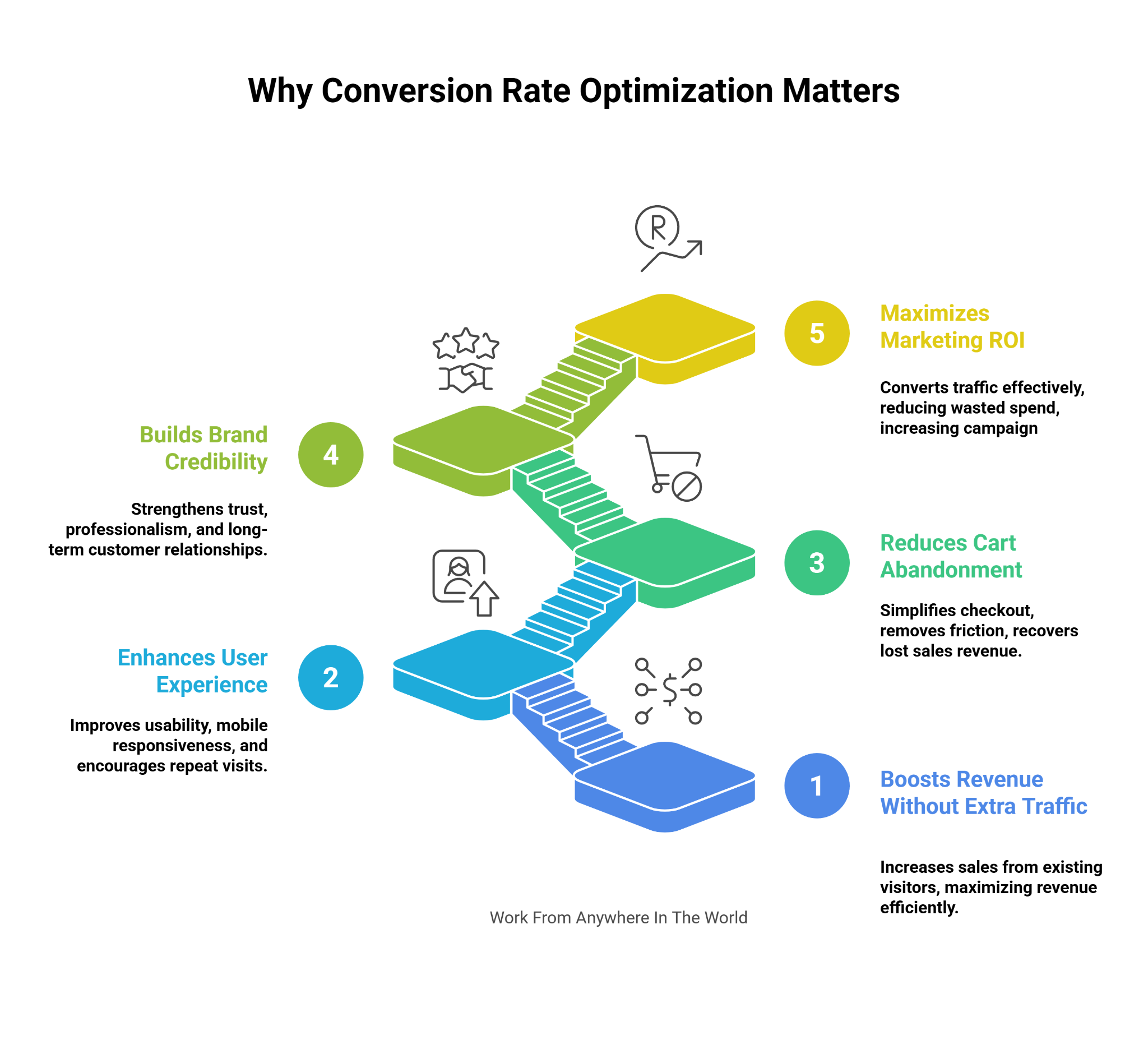
6. Supports Data-Driven Decisions
CRO relies on testing, analytics, and behaviour data to make informed decisions. Businesses can find trouble spots and make focused changes by examining how users interact with a website. This reduces guesswork and ensures that changes are backed by evidence.
Tools like A/B testing, heatmaps, and conversion tracking help teams see what works and what doesn’t. Data-driven optimization also allows for continuous refinement over time.
Each test provides insights that guide future strategies, ensuring that websites evolve with user preferences and shopping trends, leading to more effective, measurable, and sustainable growth.
Key Points
- Uses analytics and A/B testing.
- Identifies bottlenecks in user flow.
- Reduces guesswork in website changes.
- Provides measurable insights for improvement.
7. Increases Customer Lifetime Value
Optimizing the customer journey encourages repeat purchases and long-term loyalty. CRO tactics that make it easier for customers to keep making purchases include loyalty programs, streamlined navigation, and personalized recommendations.
Repeat business, larger order spending, and word-of-mouth referrals are all increased when customers are satisfied.
By enhancing the overall shopping experience, businesses nurture lasting relationships with their audience. This not only boosts immediate sales but also strengthens lifetime value, creating a consistent revenue stream.
Putting money into CRO guarantees a satisfying experience for every visitor, which increases long-term revenue and reinforces brand loyalty.
Key Points
- Encourages repeat purchases.
- Increases average order value.
- Strengthens long-term loyalty.
- Promotes referrals and advocacy.
8. Reduces Bounce Rates
A well-optimized website keeps visitors engaged longer, reducing bounce rates. CRO strategies, such as explicit content and relevant product recommendations, help maintain our interest.
Those who can swiftly and easily find what they are seeking are more likely to browse through several pages and ultimately convert.
High bounce rates often signal poor design, slow speed, or confusing interfaces. By continually testing and improving these elements, businesses can create a more engaging environment.
Lower bounce rates not only increase conversions but also improve SEO performance, making the website more visible to potential customers.
Key Points
- Enhances first impressions with fast-loading pages.
- Improves navigation and content relevance.
- Keeps visitors engaged longer.
- Increases the likelihood of conversion.
9. Provides Competitive Advantage
Businesses that actively optimize their websites often outperform competitors who neglect CRO. Faster, easier-to-navigate sites with persuasive content and clear calls-to-action attract more buyers.
CRO ensures that your store meets or exceeds customer expectations, giving it an edge in a crowded market. Brands that focus on user experience, trust, and smooth checkout processes are more likely to capture and retain customers.
Staying ahead in CRO can differentiate your business, making it the preferred choice for shoppers. Competitive advantage comes not just from products, but from the entire shopping experience, which CRO helps refine and enhance continuously.
Key Points
- Outperforms competitors in user experience.
- Encourages buyers to choose your brand.
- Differentiates the business in crowded markets.
- Improves market positioning and trust.
10. Encourages Continuous Improvement
CRO is not a one-time task; it fosters a culture of constant testing and optimization. Businesses regularly analyze metrics, run experiments, and implement changes to improve performance.
This iterative process ensures websites evolve alongside user behaviour, market trends, and technological advancements.
Continuous optimization leads to incremental gains that compound over time, resulting in sustained growth. By constantly seeking ways to enhance conversions, businesses remain agile, competitive, and customer-focused.
CRO encourages proactive problem-solving and long-term strategic thinking, allowing brands to adapt to changing needs and maintain high performance in the ever-evolving eCommerce landscape.
Key Points
- Fosters a test-and-learn mindset.
- Supports continuous site refinement.
- Adapts to changing customer behaviour
- Ensures long-term growth and competitiveness.
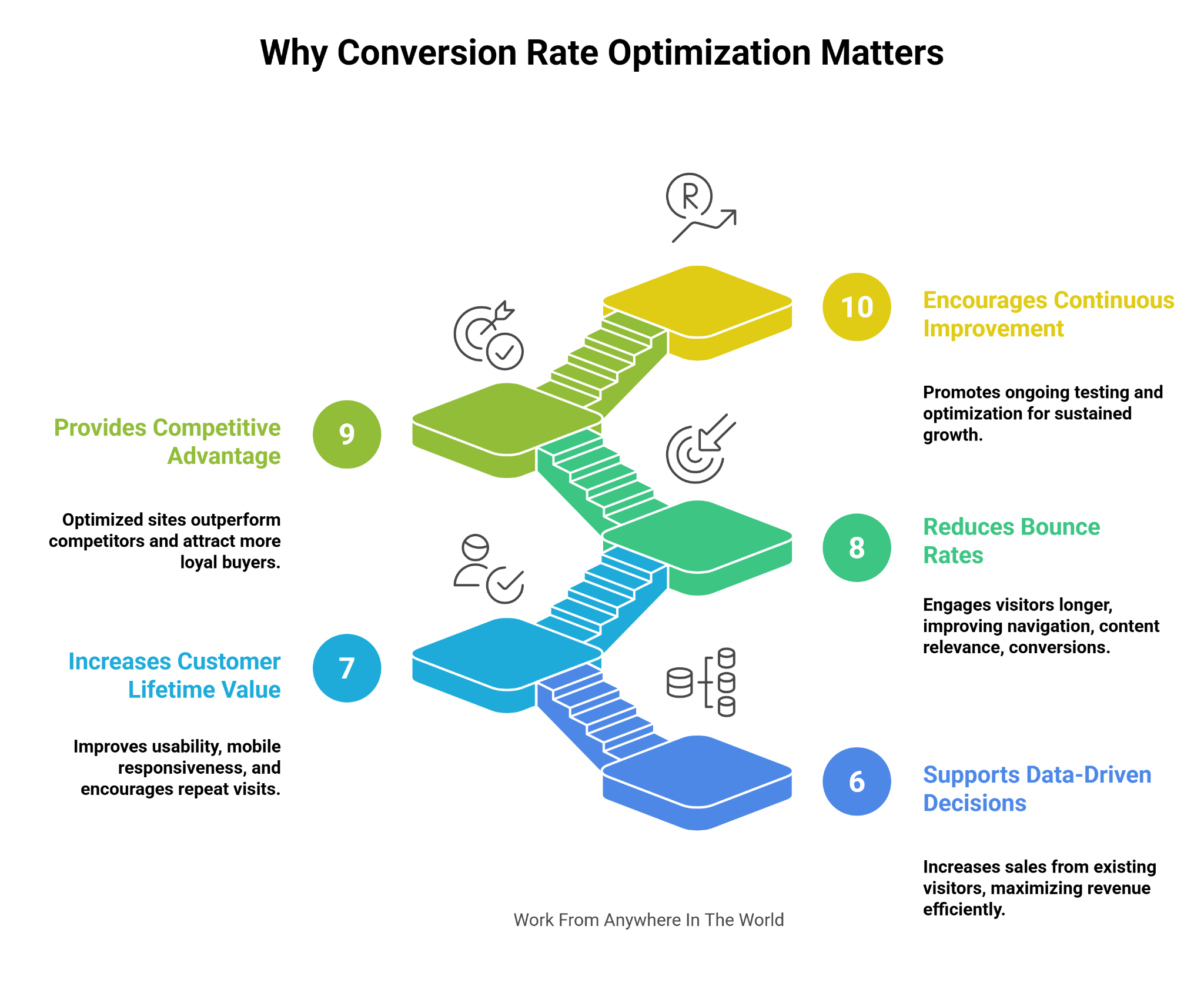
Conclusion
Implementing effective ecommerce conversion rate optimization strategies can revolutionize your online business. By analyzing behaviour design and optimizing every step of the purchase journey, you can achieve higher conversions and increased revenue.
Remember, significant results. Significantly, test regularly, and apply these tips to ensure your ecommerce store thrives. Increase your online sales by starting to optimize today.
I trust you enjoyed this article on the Proven eCommerce Conversion Rate Optimization Strategies. Please stay tuned for more insightful blogs on affiliate marketing, online business, and working from anywhere in the world.
Take care!
— JeannetteZ
💬 Your Opinion Is Important To Me
Do you have thoughts, ideas, or questions? I’d love to hear from you. Please leave your comments below or email me directly at Jeannette@WorkFromAnywhereInTheWorld.com.
📚 More Work From Anywhere Reads
🚀 Ready to Build a Business You Can Run from Home
or Anywhere in the World?
Imagine creating income on your terms — from home, a cozy café, or wherever life takes you.
With the right tools, training, and community support, it’s entirely possible.
Start your own online business for free — no credit card needed.
Disclosure
This post may contain affiliate links. As an Amazon Associate and participant in other affiliate programs, I earn from qualifying purchases at no extra cost to you. Please read my full affiliate disclosure.

